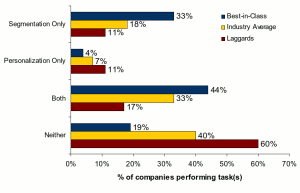
When poet John Donne wrote, “No man is an island,” he suggested that that all human beings are bound by the experiences of others. This timeless notion can also be applied to the business world: “No marketing channel is an island.” When online information is examined on a larger scale across several thousands of customers, trends emerge that lead not only to Web site optimization, but also to the improvement of offline marketing campaigns.
In “Drowning in Data: Web Analytics and Information Overload,” I discuss the challenges end-users face when it comes to converting KPI and metric reporting into action items. The article examines the use of free and paid Web analytics solutions and the corresponding frustrations users feel with each solution type. Here, I’ll examine exactly how organizations are using Web analytics data to improve marketing effectiveness.
A top challenge identified by end-users is the need to improve overall marketing effectiveness. This challenge is escalated by the fact that organizations struggle to derive actionable marketing insights from their online data. While Best-in-Class companies experience similar challenges, the implementation of key organizational capabilities and the use of analytics data within other marketing efforts results in superior performance.
The key for end-users striving to attain Best-in-Class status is to understand what metrics matter to the organization and consistently test the effect Web site content and marketing promotions have on these predetermined KPIs. The use of segmentation and personalization by Best-in-Class companies provides a blueprint for increased conversions.
Segmentation and personalization initiatives allow businesses to derive more value from their analytics data by seamlessly weaving a customer’s online actions with future marketing efforts. Companies struggling to derive the full value from their analytics solutions should view the strategies of Best-in-Class companies as road maps to success. As Web analytics becomes more and more integrated with all marketing activities, companies must have a clear idea as to what information is relevant to their business, as well as how relevant data can be used to optimize marketing communications.
Segmentation and Personalization
Companies must be sure they are serving up only the most relevant offers and messaging to online visitors; failure to do so may result in an unfavorable online experience and customer attrition. Segmentation and personalization are Best-in-Class practices for marketing success (Figure 1). Segmentation, the process by which a company divides a larger customer group into smaller subsets based on purchasing needs and behaviors, is currently utilized by 33 percent of the Best-in-Class.
Geographic indicators (69 percent), purchasing behavior (66 percent), lifestyle profiling (58 percent), and demographic information (54 percent) are the most common variables used by all businesses for segmentation purposes. These categories allow companies to target promotions to a particular segment either dynamically in real-time online, or in more traditional marketing campaigns, such as direct mail or email promotions.
Forty-four percent of Best-in-Class companies indicate that they both segment customers based on specific variables and personalize marketing messages based on information specific to each customer. In contrast, 60 percent of Laggards do neither. Fifty-four percent of Best-in-Class companies, compared to 38 percent of all others, dynamically alter online content based on a specific visitor or online behavioral pattern. Eighty-five percent of Best-in-Class companies utilize personalized emails that include such variables as the customer’s name, past purchase behavior and targeted promotions.
As personalization becomes a more fixed staple of marketing, companies must face the reality that their “personalized” marketing messages must do more than simply substitute recipient names. A business must integrate its online customer data with its email marketing solution, for instance, to generate personalized messages that reference online searches, purchases or general browsing. The result is an increased percentage of conversion rates and heightened customer satisfaction.
3 Recommendations
End-users struggling to derive meaning from their Web analytics data should consider the following steps:
- Test Early, Test Often.
The top two strategic actions for all respondents are aligning Web site analysis with overall business objectives (62 percent) and tracking and recording all customer interactions with the online channel (44 percent). Of course, these two strategies are not mutually exclusive; companies must track customer behavior to properly align analysis with business objectives. However, once the data is collected and analyzed, companies must make changes to Web site content, graphics, or “calls to action” to test which combinations result in higher conversions.
A Web content management solution allows multiple users to modify Web site content quickly and track any fluctuation in reporting. A/B content testing tools present one of two different Web pages to online visitors to gauge which one results in a higher number of clickthroughs. The key is to use analytics data to test Web site content early and often.
- Develop a Process for Segmenting Profitable Customer Characteristics.
The goal of Web analytics is to be able to predict unique user behavior to the point where relevant advertisements and calls to action are served up at crucial points of the Web session. Conversion path analysis tools, for instance, allow companies to understand the behaviors of customers who complete an online conversion. By analyzing this behavior, organizations can identify qualifying characteristics early in the visitor’s online session and serve up targeted content to stimulate a conversion.
- Integrate Analytics Data With Segmentation and Personalization Initiatives.
In some cases, Web visitors are indistinguishable from one another; however, in other cases, organizations know exactly which customer or prospect is on the site. Whether it is a unique login or unexpired cookie, businesses can often link online behavior to a specific individual. In these instances, companies must be sure to correlate the data for segmentation and personalization purposes.
As Web analytics becomes a larger piece of an integrated marketing platform, Web site behavior and purchasing history become key bits of information that can be used in conjunction with an email marketing campaign, for instance.
Aberdeen’s upcoming benchmark, “Web Analytics: Actionable Insights for Unlocking the Hidden Potential of Online Data,” which will be available for free on May 1, includes several data-driven recommendations. In the meantime, the research preview is available for download now. If you would like to contribute to the ever-growing data set, please complete the online survey.
Alex Jefferies is a senior research associate for Aberdeen Group’s customer management technologies group.


















































